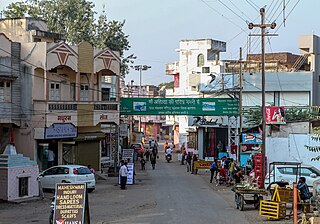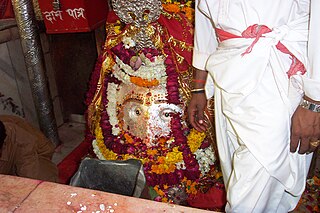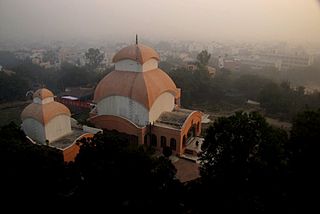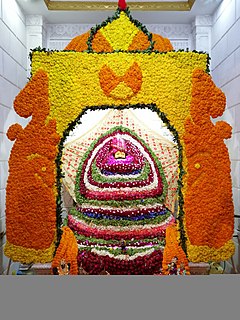
Maheshwar is a town in Khargone district of Madhya Pradesh state, in central India. It is located on State Highway-38 ,13.5 km east of National Highway 3 and 91 km from Indore, the commercial capital of the state. The Town lies on the north bank of the Narmada River. It was the kingdom of Chaktavartin Samrat Sahastraarjun, Kartavirya Arjuna a Heheya king. Lately, after many years, it was the capital of the Malwa during the Maratha Holkar reign till 6 January 1818, when the capital was shifted to Indore by Malhar Rao Holkar III.

Vaishno Devi is a manifestation of the Hindu Mother Goddess, Devi. The words "Maa" and "Mata" are commonly used in India for mother, and thus are often heavily used in connection with Vaishno Devi. Vaishnavi was formed from the combined energies of Parvati, Lakshmi, and Saraswati.

Santipur is a city and a municipality in the Ranaghat subdivision of Nadia district in the Indian state of West Bengal. The fort area of this city, also known as Daak-Garh is thought to have been built by Raja Krishnachandra of Nadia.

Kalna or Ambika Kalna is a town in the Purba Bardhaman district of West Bengal, India. It is the headquarters of the Kalna subdivision, situated on the western bank of the Bhāgirathi river. The city is more popularly known as Ambika Kalna, named after the goddess Kali, Maa Ambika. It has numerous historical monuments, such as the Rajbari, and 108 Shiva temples. The city of Kalna is 60 kilometres (37 mi) from Bardhaman.

Chittaranjan Park is an affluent and upscale neighborhood in South East Delhi and home to a large Bengali community. It was established on a rocky terrain in the early 1960s under the name EPDP Colony and later renamed after the deshbandhu (patriot) Chittaranjan Das in the 1980s. Nowadays it is considered among the posh localities in South Delhi due to a rise in the market price of its plots. Despite its growing cosmopolitan nature, it remains home to a large Bengali community and is home to Kolkata-style street-food stalls, Bengali cuisine, fish markets, temples, and cultural centers. It hosts many festivities and cultural events. Durga Puja is the most celebrated festival here which boasts magnificent marquee.

Jiaganj Azimganj is a city and a municipality in Murshidabad district in the Indian state of West Bengal.

Muktagacha is an upazila of Mymensingh District in the Division of Mymensingh, Bangladesh. It is known for sweets which are made there, called "Monda". It is also known for the Rajbari which is currently used as an educational institute, Shahid Shrity College.

Kalkaji Mandir, also known as Kalkaji Temple, is a Hindu mandir or temple, dedicated to the Hindu Goddess Kali. The temple (mandir) is situated in the southern part of New Delhi, in Kalkaji, India, a locality that has derived its name from the temple and is located opposite the Nehru Place business centre and close to the Okhla railway station, Kalkaji Mandir metro station. Hindus believe that the image of the Goddess Kalka here is a self-manifested one.

The Temple of Joy Kali in Dhaka, Bangladesh, is situated between Thathari Bazar and Wari, on a road itself named after this temple, at 24 Joy Kali Temple street. Joy Kali Temple is a Hindu temple devoted to Goddess Kali Ma. People of Hindu religion of every age come to this temple to worship Goddess Kali. The statue of Goddess Kali is of great significance to the Hindus. The visitors and committee members of this temple gather money for occasions, where sweets are later distributed among them which is called 'Prasad'.

Chittaranjan Park Kali Mandir is a temple complex and Bengali community cultural center in Chittaranjan Park in New Delhi, India. Built on a small hill, it started as a Shiv temple in 1973, which still stands within the complex, the larger shrines dedicated to goddess Kali, Shiva, and Radhakrishna were added in 1984. Over the years it has remained an important centre of convergence of local Bengali community during annual Durga Puja festivities.
In religion and spirituality, a pilgrimage is a very long journey or search of great moral significance. Sometimes, it is a journey to a sacred area or shrine of importance to innate faith. Members of every major religion participate in pilgrimages. A person who makes such a journey is called a pilgrim.

Shree Shyam Mandir, Guwahati is a temple located in Chatribari, one of the main trade hubs in the Indian city of Guwahati. It has His Supremacy, Shri Khatushyamji or Shyam baba as the presiding deity and many sub-temples dedicated to other deities including: Their Most Excellent Lordships, Shri Ganeshji, Biyala's sati dadi or Bajawa ki sati dadi, Shri Balaji Maharaj, Shri Shiva Parivar, Shri Lakshmi Mata, Shri Rani Sati Dadiji, and Shri Santoshi Maa. The temple is visited by hundreds of Shyam Bhakts daily, especially during Aartis and a larger number on Ekadashis and a still larger number on the Shukla paksha Ekadashis of the Kartik, Falgun and Margshirsh months of the Hindu lunar calendar.
Kodlamane is a Tirth Khestra and Hindu pilgrimage site where Kodlamane Shree Vishnumurthy Temple is located. It is located in a hill forest. As per local legend the temple was discovered in the middle of dense forest centuries back. It is in Honnavar Taluka of Uttara Kannada district in Karnataka state. A natural stream flows next to the Shree Vishnumurthy Temple, which is called Vishnu Tirth.

Tangail District is quite famous for it's zamindari rule with three of the largest zamindars in the region believed to have been established during the Mughal period. In addition, several small zamindar classes developed in this area, whose reputation is still evident. One of such zamindar is Mohera Zamindar Bari. Mohera Zamindar Bari is a 19th-century Zamidari residence in Mirzapur, Tangail District, Bangladesh. It is used as a police training school.The zamindar house was established in the mirzapur before the 1890s.Mohera zamindar Bari is the most preserved and maintained zamindari Bari of Bangladesh locally. There is no such zamindari Bari as preserved and maintained as it is in the country. The zamindari Bari represents our culture, lifestyle, and history during British time.

Shiva Temple of Stone is an ancient temple and archeological site located in Mymensingh district of Bangladesh. Raja Jagat Kishore Acharya, the then zamindar of Atani in Muktagachha built the temple with the help of architect Moyez Uddin. It is the temple set up by the zamindars in front of the Armed Police Battalion Camp in Muktagachha town of Muktagachha upazila of Mymensingh district. The distance from Muktagachha Upazila to the temple is 18 kilometers.

Basuki Bihari is a big village in the Madhubani district in State of Bihar, India. According to India Population Census 2011 the population of the village is 14385. The majority of people of this village speak in Maithili language. The total area of the village is 13.62 km2. The village is divided into two Gram Panchayat Basuki Bihari North and Basuki Bihari South. The head of the Gram Panchayat is called as Mukhiya. Mukhiya is elected by adult people of the village. The election of Mukhiya is held by the Election Commission of Bihar state. This village is very famous for social cultural activities like Durga Puja, Chhath, Kali Puja and Sarswati Puja. The village is connected by State Highway No 75 from Darbhanga to Madhwapur. This village is only two kilometres far from the Indo-Nepal Border at Madhwapur in Madhubani district.

Sri Sri Kali Mata Mandir is one of the famous Hindu temples in Bangladesh. According to legend, the goddess Kali appeared miraculously at this place about 108 years ago. It is located between the villages of Fandauk and Morakari in Lakhai upazila of Habiganj district of Bangladesh.















